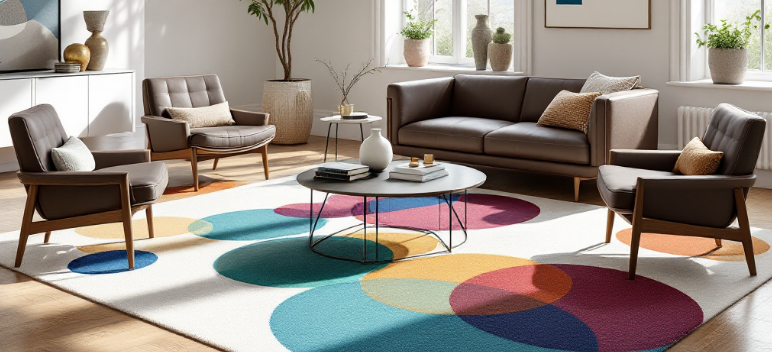
How Can I Stop a Rug from Moving on a Carpet
|
Time to read 5 min
|
Time to read 5 min
Walking into a room to find your decorative rug has shifted, bunched up, or created unsightly wrinkles can be frustrating.
Not only does this look untidy, but it can also create potential tripping hazards in your home. Understanding how to effectively secure your rug to your carpet is essential for both safety and aesthetics.
Before diving into solutions, it's important to understand why rugs tend to move on carpeted surfaces.
The primary cause is the interaction between the two fabric surfaces, where the fibres can create friction that leads to movement, especially in high-traffic areas.
Additionally, factors such as the weight of the rug, the type of carpet pile, and even humidity can contribute to this common household problem.
The thickness and material composition of both your carpet and rug play crucial roles in how they interact. Lighter rugs on plush carpets are particularly prone to movement, while heavier rugs with natural fibres might stay in place more readily but can still shift over time.
Need Inspiration? View Our Most Popular Living Room Furniture Here.
Professional rug installation experts often employ specific techniques that you can replicate at home.
The key is selecting the right method based on your specific rug and carpet combination. Non-slip rug pads designed specifically for carpet-to-rug application are widely considered the most effective solution by industry professionals.
When choosing a securing method, consider factors such as the size and weight of your rug, the type of carpet pile, and the amount of foot traffic in the area. Professional-grade solutions often provide better longevity and reliability compared to temporary fixes.
Here's a comprehensive comparison of different rug securing methods based on consumer testing:
| Method | Effectiveness Rating | Durability (months) | Cost Range (£) | Ease of Installation |
|---|---|---|---|---|
| Double-sided tape | 7/10 | 3-6 | £5-15 | Very Easy |
| Rug grippers | 8/10 | 12-24 | £10-30 | Easy |
| Non-slip rug pads | 9/10 | 24-36 | £15-45 | Easy |
| Velcro strips | 6/10 | 6-12 | £8-20 | Moderate |
| Carpet tape | 7/10 | 6-18 | £7-25 | Easy |
According to the Health and Safety Executive , proper floor covering installation is crucial for preventing slip and trip accidents in both homes and workplaces. Using appropriate anchoring methods not only enhances safety but also maintains the aesthetic appeal of your space.
The UK Government's Housing Health and Safety Rating System emphasises the importance of properly secured floor coverings in preventing household accidents. This is particularly relevant for households with elderly residents or young children.
After exploring various methods and techniques, it's clear that preventing rug movement on carpet requires a systematic approach.
The most effective solution typically combines proper preparation, appropriate materials, and regular maintenance. Remember that what works best will depend on your specific situation and the materials involved.
Professional rug installers consistently emphasise the importance of selecting the right combination of securing methods based on your specific needs.
This might mean using different techniques for different areas of your home, depending on factors such as foot traffic and rug size.
The key to long-term success lies in regular monitoring and maintenance of whatever solution you choose. Here are the three most crucial points to remember:
Need Furniture Inspiration? View Our Most Popular Living Room Furniture Here
Rugs move on carpet primarily due to friction between the two surfaces and foot traffic patterns. The combination of different fabric textures and daily use creates conditions where movement becomes inevitable without proper securing methods.
Quality rug grippers are specifically designed to be safe for all carpet types, including high-end materials. Always check product specifications and test on a small area first to ensure compatibility with your specific carpet fibres.
You should inspect your rug's securing methods every 3-6 months and after any deep cleaning. Regular checks help prevent potential safety hazards and maintain the effectiveness of your chosen securing method.
You should inspect your rug's securing methods every 3-6 months and after any deep cleaning. Regular checks help prevent potential safety hazards and maintain the effectiveness of your chosen securing method.
Yes, changes in humidity can affect the grip between your rug and carpet. High humidity can cause fibres to expand and contract, potentially affecting the effectiveness of certain securing methods.
The most effective solution for corner curling is using combination of rug weights and corner grips. These methods work together to maintain tension across the rug's surface while securing the corners firmly in place.
Your rug pad should be approximately 2.5 cm smaller than your rug on all sides. This ensures the pad remains hidden while providing maximum stability and preventing edge lifting.
While some methods overlap, outdoor rugs often require different securing techniques due to their construction and intended use. Always check manufacturer recommendations for specific guidance.
While no solution is truly permanent, professional-grade rug pads and properly installed grip strips can provide long-term stability. Regular maintenance and adjustment will still be necessary for optimal results.
While no solution is truly permanent, professional-grade rug pads and properly installed grip strips can provide long-term stability. Regular maintenance and adjustment will still be necessary for optimal results.
Using non-adhesive rug pads and removable grip systems designed specifically for carpet applications will help prevent damage. Avoid any permanent adhesives or modifications to your carpet.
Double-sided carpet tape is generally the most cost-effective solution, though investing in a quality rug pad might provide better value over time due to its durability and effectiveness.
Yes, combining compatible methods like rug pads with corner grips can provide enhanced stability. Just ensure the methods don't interfere with each other's effectiveness.
Large rugs require more comprehensive securing methods, as detailed on Wikipedia's Carpet page . Consider using multiple rug pads or professional installation for optimal results.

